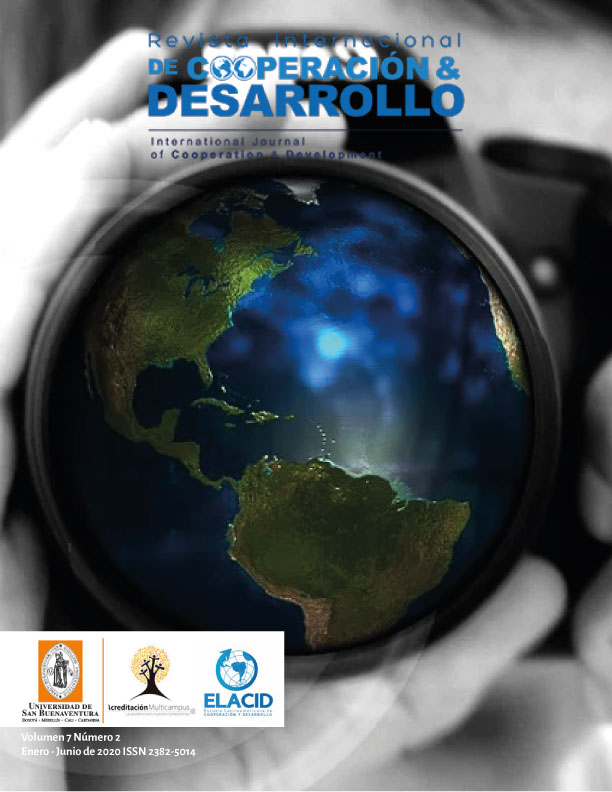INTERNATIONAL JOURNAL OF COOPERATION AND DEVELOPMENT
Assignment of Rights
Authorization for reproduction, publication, communication and distribution of a literary, artistic or scientific
Work.
I , ____________________________________________, author of the book and / or article , of legal age , resident of the city of _________________ , identified with citizenship / passport n° ______________________ issued on _______________________, in exercise of his physical and mental faculties , part henceforth be called the AUTHOR , supports the following authorization to the reproduction, publication, communication and distribution of a work, perform the following terms:
1. Regardless of current legal regulations due to the linking of the parties to this contract, and any kind of legal presumption , the parties agree that the AUTHOR authorize ( name of the publisher ) to reproduce , publish , communicate and distribute the material referred to in the International Journal of Cooperation and Development of the University of San Buenaventura.
2. Such authorization lies in particular on the copyright of the work, by any means known or unknown, publication of the work, distribution of the work , either directly or through third parties for purely educational purposes.
3. AUTHOR agrees to report and declare the existence of this authorization and to preserve the right of the International Journal of Cooperation and Development of the first publication of the work.
4. AUTHOR declares that the article is original and that it is his sole creation, no impediment of any kind exist for the authorization he is doing, besides being responsible for any action claim, plagiarism or other type of claim that might arise about .
5. Such permission is free of charge.
6. Moral copyright in the article are solely the AUTHOR and the University of San Buenaventura expressly agrees to recognize and respect them rigorously.
The Author and / or AUTHORS
SIGNATURE
Abstract
The main objective of this article is to verify the existence of differences between groups of countries according to their income level, related to the dimensions of inputs and innovation products according to the GII. The focus of the present investigation is quantitative and the method used is inferential corresponding to the analysis of variance (ANOVA). The main result of this analysis was able to empirically verify that there are differences between groups of countries, in relation to their performance in the input dimensions; while the equality of means for the performance in the output dimensions is verified for the groups of countries of Middle-low and Low income.
References
Aguilar-Barceló, J. G., & Higuera-Cota, F. (2019). Los retos en la gestión de la innovación para América Latina y el caribe: un análisis de eficiencia. Revista de La CEPAL, 2019(127), 7–26. https://doi.org/10.18356/bd1b3729-es
Antonelli, C. (2009). The economics of innovation: From the classical legacies to the economics of complexity. Economics of Innovation and New Technology, 18(7), 611–646. https://doi.org/10.1080/10438590802564543
Banco Mundial. (2020). Informe Sobre el Desarrollo Mundial. 143–143. https://doi.org/10.30875/ec431fe5-es
Dutrénit, G., Moreno, J. C., & Puchet, M. (2013). Crecimiento económico, innovación y desigualdad en América Latina: Avances, retrocesos y pendientes Post-Consenso de Washington. Serie Estudios y Perspectivas - CEPAL, 144, 1–52. http://repositorio.cepal.org/bitstream/handle/11362/4929/1/LCL3673_es.pdf
Erciş, A., & Ünalan, M. (2016). Innovation: A comparative case study of Turkey and South Korea. Procedia -Social and Behavioral Sciences, 235, 701–708. https://doi.org/10.1016/j.sbspro.2016.11.071
Franco, C., & Oliveira, R. H. de. (2017). Inputs and outputs of innovation: analysis of the BRICS. RAI Revista de Administração e Inovação, 14(1), 79–89. https://doi.org/10.1016/j.rai.2016.10.001
Furman, J. L., Porter, M. E., & Stern, S. (2013). The determinants of national innovative capacity. Research Policy, 31(2002), 899–933.
Grupp, H., & Schubert, T. (2010). Review and new evidence on composite innovation indicators for evaluating national performance. Research Policy, 39, 67–78. https://doi.org/10.1016/j.respol.2009.10.002
Hamidi, S., & Berrado, A. (2018). Segmentation of innovation determinants: Case of the global innovation index. ACM International Conference Proceeding Series, 1–8. https://doi.org/10.1145/3289402.3289548
Khedhaouria, A., & Thurik, R. (2017). Configurational conditions of national innovation capability : A fuzzy set analysis approach. Technological Forecasting & Social Change. https://doi.org/10.1016/j.techfore.2017.04.005
Kijek, A., & Kijek, T. (2010). The Analysis of Innovation Input-Output Relationships in Eu Member States. Comparative Economic Research. Central and Eastern Europe, July 2015. https://doi.org/10.2478/v10103-009-0040-5
Kim Le, S. T. (2019). Innovation efforts in developing countries The case of Vietnamese small and medium-sized enterprises. In WIDER Working Paper (No. 7; Issue February).
Kiselakova, D., Sofrankova, B., Onuferova, E., & Cabinova, V. (2020). Assessing the effect of innovation determinants on macroeconomic development within the EU (28) countries. Problems and Perspectives in Management, 18(2), 277–289. https://doi.org/10.21511/ppm.18(2).2020.23
Nelson, R. R. (1993). National innovation systems. A comparative analysis. Oxford University Press.
Porter, M. E., & Stern, S. (1999). The New Challenge to America’s Prosperity : Findings from the Innovation Index. In Council on Comptetiveness.
Ramos Álvarez, M. (2007). Capítulo 9. Análisis de Varianza (un factor): ANOVA (Análisis Multivariado de Datos Procedentes de Investigaciones Mediante Programas Informáticos I. Nivel Avanzado-Enfoque Explicativo.).
Reis, D. A., De Moura, F. R., & De Aragão Gomes, I. M. (2018). The linkage between input and output in The Global Innovation Index. Proceedings of the European Conference on Innovation and Entrepreneurship, ECIE, 2018-Septe, 635–642.
Romer, P. M. (1990). Endogenous Technological Change. Journal of Political Economy, 98, S71–S102. http://pages.stern.nyu.edu/~promer/Endogenous.pdf
Saren, M. A. (1984). A classification and review of models of the intra firm innovation process. R&D Management, 14(1), 11–24. https://doi.org/10.1111/j.1467-9310.1984.tb00504.x
Sohn, S. Y., Kim, D. H., & Jeon, S. Y. (2015). Technology Analysis & Strategic Management Re-evaluation of global innovation index based on a structural equation model. Technology Analysis & Strategic Management, November, 1–14. https://doi.org/10.1080/09537325.2015.1104412
Todeva, E. (2020). The Global Innovation Index as a Measure of Triple Helix Engagement. In Proceedings of the II International Triple Helix Summit (Vol. 43, Issue 0, p. 6221).
Tziogkidis, P., Philippas, D., Leontitsis, A., & Sickles, R. C. (2020). A data envelopment analysis and local partial least squares approach for identifying the optimal innovation policy direction. European Journal of Operational Research, 285(3). https://doi.org/10.1016/j.ejor.2020.02.023
Universidad de Cornell/INSEAD. (2011). The Global Innovation Index 2011: Accelerating Growth and Development. In France: Insead (Issue July 2011).
World Bank. (2019). Nueva clasificación de los países según el nivel de ingresos para 2019 y 2020. https://blogs.worldbank.org/es/opendata/nueva-clasificacion-de-los-paises-segun-el-nivel-de-ingresos-para-2019-y-2020
World Economic Forum. (2017). The Global Competitiveness Report. 2017-2018 (Kalus Schwab & Xavier Sala-i-Martín (Eds.)). http://www3.weforum.org/docs/GCR2017-2018/05FullReport/TheGlobalCompetitivenessReport2017–2018.pdf














